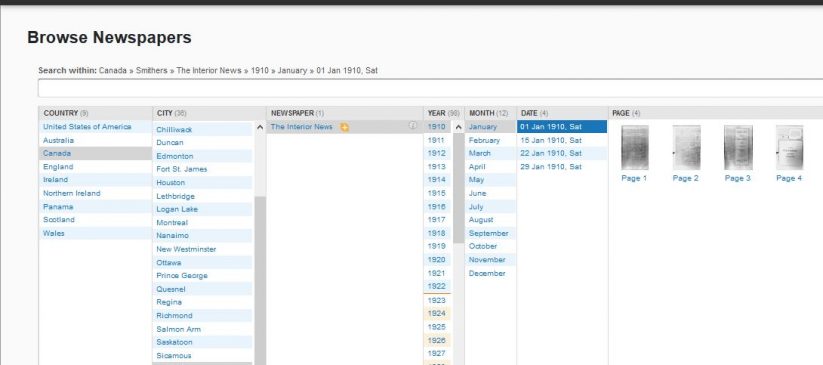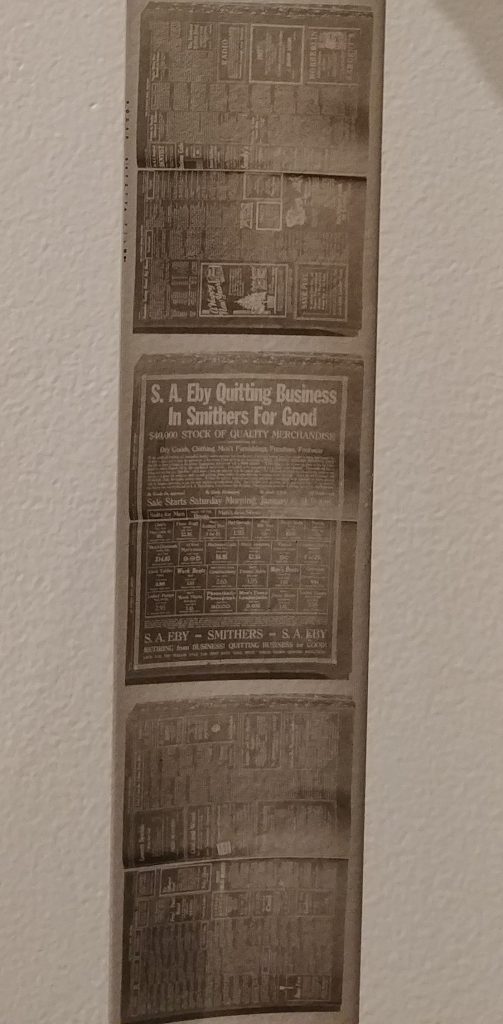
Last month, Newspapers.com digitized the Interior News from the microfilmed editions stored in our archives. Now anyone with an internet connection and a subscription to Newspapers.com can search our local paper from 1910 to 2007!
This is a big deal for BV Museum staff. One of our many jobs at the museum is to help people with local history questions: can you find the obituary of my great grandfather? When did the local Home Hardware open? Who was the doctor here in the 1920s? Many of our archival collections can help answer these questions, but one of the best available resources are the back issues of the Interior News. The newspapers are also valuable (and enjoyable to read!) due to the wealth of juicy detail about everyday life in our community found throughout the pages – from who was in court, to who was in the hospital, to who hosted a garden party on Sunday. Store openings and closing, events and celebrations, political elections, op-eds – all of it was covered in the Interior News.
Until recently, searching the Interior News meant consulting our microfilm collection. Microfilm, stored on rolls similar to camera film, is a common way to store newspaper and magazine archives. Each roll contains thousands of miniature images – each of these images is a single page of a newspaper or other document. In our collection, a typical roll contains the issues from two to three years of a newspaper’s archive. To view these rolls means using a special viewer that projects light through the film and magnifies the resulting image on a screen. Our microfilm collection consists of the Interior News archive of 1910 to 2007 and several decades of The Houston Today, two years of The Hazelton Queek from 1880-81, as well as the The Omenica Herald and Omineca Miner (both of which are also available online via the BC History Digitization Project).

Microfilm is a great way to store archival material as it allows researchers to consult documents without causing wear and tear to the originals from handling.[1] It also significantly reduces the amount of storage space needed to store the information.

However, using microfilm can make research tedious. Researchers consulting our microfilm must hunch over the viewer in a dark room, manually scrolling through issue after issue of the paper looking for the information they want. And even after all that work there’s no guarantee that they will find the information they seek. For example, what if a researcher wants to know more about a car crash which they believe happened in the winter of 1956. If the crash *actually* happened in the summer of 1957, the researcher would be looking in the wrong year and the wrong season. With microfilm, research questions that begin from incorrect or incomplete information are often more difficult to answer – if not impossible.
With the Interior News online, everything changes.
No longer do we have to pull a roll of microfilm, manually load it into the viewer, and squint at the resulting negatives; we can travel back in time with a few clicks of the mouse from our office computer. Most importantly, the Interior News is now searchable. That example discussed above (the 1957 car crash) is now much easier to resolve. A search for the place the crash occurred, the name of someone involved, or even just the phrase “car crash”, combined with narrowing the results to the 1950s and, voila: a list of just thirty-nine results to consult. What was nearly impossible before can now be completed in a matter of minutes.[2]

This revolutionizes the way we can research exhibits and help with historical questions. For our recent exhibit that featured Smithers’ early Chinatown, hours and hours we spent combing the 1920s and 1930s issues for any reference to Chinatown or local Chinese residents. During the research for Tyler McCreary’s Shared Histories book, even more hours were spent in the BC Archives in Victoria and at the BV Museum, trawling through the Interior News looking for references to early Witsuwit’en residents of Smithers. With the Interior News online, this promises to make these undertakings significantly more efficient.
It’s not only a great boon for us – it’s a great boon for you! Never before has the history of the town been so accessible to the average person. You can search your own name and see all the times you were locally famous. You can relive the Smithers Hockeyville run of 2006, read the breaking news about the Smithers bank robbery of 1929, or research the great Main Street fire of 1945.
Newspapers.com is behind a paywall, but both the BV Museum and the Smithers Library will have subscriptions to the service that the public can use.[3] We encourage the public to give us a call at 250-847-5322 to schedule an appointment to access this great resource. Our microfilm will remain as a local back-up of the Interior News archive.
We would like to thank Grant Harris at the Interior News, Elizabeth Bell at Newspapers.com, and Black Press. While we lent the microfilm for the digitization, these people and organizations actually made this revolution possible. We’d also like to thank Lorraine Dorian, Joan Warmerdam, and other members of the previous Interior News digitization committee who laid the groundwork for this project several years ago.
FOOTNOTES
[1] Reducing wear and tear on the original documents is also a reason the BV Museum is digitizing other archival items in its collections too!
[2] The search functionality is sadly not 100% perfect. This is a result of issues with the creation of the original microfilm (e.g. poorly scanned images, edges cut off if scans were made from bound volumes) as well as the condition of the reels after decades of use (e.g. scratches). These issues have been transferred to the digital version. Researchers wanting a comprehensive search of a particular event or person will need to dig deeper than simple keyword searches.

[3] The BV Museum’s subscription is currently available for use. The Library’s is still forthcoming.